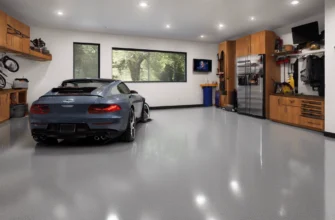- Introduction to Epoxy Flooring
- Understanding Oil Stains and Chemical Spills
- The Protective Qualities of Epoxy Flooring
- Why Epoxy is Ideal for Automotive Use
- Installation Process of Epoxy Flooring
- Maintenance Tips for Epoxy Floors
- Cost Considerations for Epoxy Flooring
- Real-Life Success Stories
- Conclusion and Recommendations
Introduction to Epoxy Flooring
Epoxy flooring is a popular flooring solution that consists of a mixture of resin and hardener, creating a durable and long-lasting surface. This composition allows for a seamless finish that is both resistant to wear and tear and aesthetically pleasing. The epoxy layers can be applied on concrete surfaces, providing a protective layer that enhances the underlying material’s strength and longevity. Commonly utilized in various environments, including commercial spaces, industrial settings, and residential garages, epoxy flooring excels in circumstances where durability is vital.
One of the standout attributes of epoxy flooring is its exceptional resistance to chemicals, which makes it an ideal choice for automotive garages. Oil stains and chemical spills are common occurrences in such settings, and an epoxy-coated floor can significantly mitigate these issues. Its non-porous surface prevents liquids from penetrating, enabling easy cleanup and preventing long-lasting damage to the flooring. This characteristic is particularly important for maintaining a clean and professional environment in garages where automotive work is performed.
Beyond its resilience, epoxy flooring is also favored for its versatility in design. Available in various colors and finishes, it allows garage owners to customize their space according to personal taste or business branding. Furthermore, its reflective properties contribute to better lighting, enhancing visibility and safety in the work area. The low maintenance requirements of epoxy flooring also appeal to those seeking a practical solution that does not compromise on quality or appearance.
In conclusion, epoxy flooring is a robust and versatile option that offers significant benefits, particularly in environments vulnerable to stains and spills, such as automotive garages. With its composition tailored for durability, ease of maintenance, and customization, it is gaining popularity among both homeowners and professionals alike.
Understanding Oil Stains and Chemical Spills
Garages frequently serve as spaces for vehicle maintenance and repairs, which often result in the common occurrence of oil stains and chemical spills. Motor oil is one of the most prevalent substances that lead to staining and damage. This viscous liquid can seep into porous concrete, leaving unsightly dark patches that can be challenging to remove. In addition to motor oil, transmission fluid is another automotive substance that can create similar staining issues. Its distinct bright red or green coloration can mar the appearance of a garage floor while compromising the integrity of the concrete.
Moreover, various automotive chemicals such as antifreeze, brake fluid, and solvents are routinely used in garages and pose a threat to flooring materials. Antifreeze, for example, contains glycol, which can attack the structure of unprotected concrete. Brake fluid, known for its corrosive properties, can peel paint and erode surfaces. Even water-based and paint-thinner spills can adversely affect the longevity and aesthetic value of concrete flooring. These spills not only tarnish the visual appeal but may also lead to deep-seated damage over time if left unaddressed.
The reasons for concern extend beyond mere aesthetics; the repercussions of neglecting oil stains and chemical spills can escalate significantly. Unprotected concrete floors can suffer from cracking and pitting, ultimately necessitating extensive repairs or replacement. Additionally, the potential safety hazards posed by slippery surfaces increase the risk of accidents in the garage. Therefore, it is crucial to consider effective protection strategies, such as applying a durable floor coating, to mitigate the damaging effects of these automotive substances.
The Protective Qualities of Epoxy Flooring
Epoxy flooring has gained recognition as an exceptional solution for garage environments due to its myriad protective qualities. One of the standout features of epoxy flooring is its remarkable resistance to solvents, oils, and chemicals. This intrinsic property makes it an ideal choice for garages, where exposure to automotive fluids, cleaning agents, and various chemicals is commonplace. Unlike traditional flooring materials, which can be easily stained or damaged by such substances, epoxy forms a durable barrier that prevents penetration and facilitates easy cleanup.
Moreover, epoxy flooring exhibits impressive durability suited for heavy vehicle traffic. This characteristic is particularly important in garage settings, where vehicles frequently enter and exit. Epoxy coatings are not only designed to withstand substantial weight but also resist the wear and tear associated with repeated use over time. This durability means less frequent need for replacements or repairs, leading to cost-effective long-term maintenance.
In addition to its resistance and durability, the non-porous nature of epoxy flooring further enhances its protective qualities. Unlike concrete, which can absorb spills or stains, epoxy creates a seamless surface that stands up to moisture and prevents the growth of mold and mildew. This is essential in preserving the structural integrity of the garage, as well as maintaining a clean and hygienic environment.
Furthermore, the application of epoxy flooring can significantly improve traction, reducing the risk of slips and falls, especially in instances where spills might occur. Some epoxy coatings can be formulated with additives to enhance grip without compromising the overall aesthetic appeal. This combination of functionality and safety underscores why epoxy is considered one of the best choices for coating garage floors.
Why Epoxy is Ideal for Automotive Use
Epoxy flooring has gained significant popularity in automotive garages, primarily due to its remarkable durability and functionality. One of the standout advantages of epoxy is its non-slip surface, which is particularly beneficial in environments where spills are common. This feature is essential for safety, as it reduces the risk of slips and falls while working on vehicles. The textured finish of epoxy not only provides traction but also ensures confidence during movement, even when the floor may be wet from oil or other fluids.
Another significant attribute of epoxy flooring is its ease of cleaning. Automotive environments inevitably encounter spills from oil, antifreeze, and other chemicals. Epoxy’s seamless surface prevents liquid absorption, making it simple to wipe away spills without the fear of staining. A quick sweep or a mop with a mild detergent can restore the floor’s appearance, eliminating the need for extensive maintenance. This ease of maintenance contributes to a healthier working environment as well, reducing the likelihood of slippery residues and fostering a cleaner space for automotive tasks.
Moreover, epoxy flooring sustains its aesthetic appeal, even after prolonged exposure to harsh substances. Unlike traditional flooring options, which may discolor or degrade over time, epoxy is engineered to withstand the rigors of an automotive garage. Its resistance to stains and chemicals ensures that the garage retains a professional and polished look, which is particularly important for businesses focused on customer experience. In essence, the integration of epoxy flooring not only enhances the functionality of the garage but also elevates its overall appearance and cleanliness, making it a prudent choice for automobile enthusiasts and mechanics alike.
Installation Process of Epoxy Flooring
The installation of epoxy flooring in a garage is a meticulous process that significantly contributes to its protective qualities against oil stains and chemical spills. Proper installation begins with surface preparation, which is crucial for ensuring a strong bond between the epoxy and the concrete. This involves cleaning the floor thoroughly, repairing any cracks or holes, and sometimes grinding or shot-blasting the concrete surface to achieve a smooth, rough texture. These preparatory steps prevent any contaminants from compromising the integrity of the epoxy coating.
Once the surface is adequately prepared, the next step is the application of the epoxy. This can be executed using different methods, such as roller application or squeegee application, depending on the thickness of the epoxy layer and the specific requirements of the garage. The application typically consists of a base coat, followed by additional layers, including a decorative chip layer, if desired. Each layer must be allowed to cure for a specific amount of time; this is crucial to achieve the desired hardness and durability. Curing times can vary based on environmental conditions, such as humidity and temperature, with standard curing times ranging from 24 to 72 hours.
Several factors can affect the longevity of the epoxy flooring. These include the quality of the materials used, the climate in which the garage is located, and the amount of foot and vehicular traffic the floor endures. Additionally, professional installation is highly recommended to ensure that all steps are carefully followed and that the final product achieves optimal strength and resilience. A professional installer can provide insights into the best products and practices tailored to specific garage conditions, further enhancing protection against oil stains and chemical spills.
Maintenance Tips for Epoxy Floors
Maintaining epoxy flooring in your garage is essential to ensure its longevity and pristine appearance. Regular upkeep can prevent issues such as oil stains and chemical spills from causing lasting damage. One of the primary steps in maintenance is promptly addressing any spills. When a liquid is spilled, whether oil or a chemical, it is crucial to act quickly. Use absorbent materials such as paper towels or rags to soak up the spill and then clean the area with a mild detergent diluted in water. Avoid using harsh chemicals, as these could degrade the epoxy finish.
For general cleaning, a simple method is to sweep the floor frequently to remove dust and debris, followed by mopping with a pH-neutral cleaner specifically designed for epoxy surfaces. This not only enhances the floor’s appearance but also reduces the chance of any particles scratching the surface during subsequent activities. It’s advisable to avoid abrasive tools, as these can damage the glossy finish of your epoxy flooring.
Another recommended practice is to conduct periodic inspections of your garage floor. Look for any signs of wear or minor damages, such as small chips or scratches. If identified, these can often be addressed easily with a patching compound specifically formulated for epoxy floors. Following the manufacturer’s instructions, apply the compound and allow it to cure properly before subjecting the area to regular use. This proactive approach helps maintain the integrity and functionality of the flooring.
Lastly, consider applying a sealant every few years to protect against future stains and spills. Sealing your epoxy floor can provide an additional layer of defense, making it more resistant to chemicals and wear over time. By following these maintenance tips, you can ensure that your epoxy flooring remains an effective and attractive surface for your garage.
Cost Considerations for Epoxy Flooring
When contemplating the installation of epoxy flooring in a garage, several cost factors come into play that can significantly influence the overall expenditure. Initially, the upfront cost of materials and professional installation can vary widely, influenced by the type of epoxy chosen, the size of the garage, and any necessary preparatory work to ensure optimum adhesion and durability. Generally, basic epoxy coatings can range from $2 to $7 per square foot, while high-performance systems and decorative options may cost upwards of $10 per square foot.
In comparing short-term versus long-term costs, it is crucial to consider the longevity of epoxy flooring, which can last anywhere from 10 to 20 years with proper maintenance. The initial investment might seem daunting, but the durability of epoxy reduces the frequency of replacement associated with traditional flooring materials. This longevity translates to a notable reduction in long-term expenses, including the costs of repairs and replacements for stained or damaged floors.
Moreover, one of the significant advantages of installing epoxy flooring is the potential savings on maintenance and damage repairs. Oil stains and chemical spills, common in garages, typically require frequent cleaning and may lead to permanent damage on porous surfaces. The non-porous nature of epoxy flooring makes it easy to clean and resistant to staining, thereby minimizing the time and money spent on maintenance efforts over time.
Homeowners should also consider the return on investment (ROI) when evaluating the costs associated with epoxy flooring. A garage with durable, attractive epoxy flooring can enhance the property’s value, making it an appealing feature for potential buyers. Overall, while the initial costs may appear significant, the long-term savings and increased property value can offer substantial returns, making epoxy flooring a wise investment for homeowners looking to protect and enhance their garages.
Real-Life Success Stories
Numerous homeowners and automotive businesses have turned to epoxy flooring as a solution for their garage flooring needs, specifically to combat oil stains and chemical spills. Their experiences highlight the effectiveness of epoxy coatings in providing a long-lasting and protective surface.
One homeowner, Sarah Johnson, shared her journey of transforming her garage with epoxy flooring. After years of dealing with unsightly oil stains from vehicle maintenance, she decided to invest in a professional epoxy coating. Following the application, Sarah noticed a dramatic change not only in the aesthetics of her garage but also in its maintenance. Oil spills and other chemicals simply wiped away from the smooth surface, eliminating the worry associated with permanent damage to her garage floor. Her before-and-after photos underscored the stark contrast, showcasing a clean and inviting space once marred by stains.
Similarly, a local automotive shop, Precision Auto Care, experienced transformative results with their epoxy flooring installation. Initially plagued by stained and damaged concrete, the shop sought a durable solution. Their epoxy flooring not only enhanced the appearance of their workspace but also significantly reduced the time spent on cleaning. Oil and chemical spills, which had once been a persistent issue, became far less problematic with the new flooring. The shop reported increased customer satisfaction due to the clean and professional environment, making it an essential investment for their business. Before-and-after images from Precision Auto Care illustrate the significant improvements that epoxy flooring can achieve.
These testimonials and case studies reveal the outstanding benefits that epoxy flooring provides. From residential garages to automotive businesses, the protective qualities against oil stains and chemical spills are evident and serve as strong endorsements for those considering similar renovations.
Conclusion and Recommendations
In evaluating the advantages of epoxy flooring, it becomes evident that this solution offers significant protection for garages against common challenges such as oil stains and chemical spills. By forming a robust and impermeable barrier, epoxy flooring not only enhances the aesthetic appeal of the garage but also ensures maintenance is straightforward and cost-effective. The seamless nature of epoxy means that spills are easily cleaned, and the risk of staining is notably reduced.
When considering the selection of the right epoxy product, it is essential to assess various factors, including the type of resin, the finish options available, and specific formulations designed for high-traffic areas. Some epoxies are designed to withstand not only everyday wear and tear but also the harshness of automotive fluids and chemical agents, making them an ideal choice for any garage environment.
Furthermore, it is advisable to consult with experienced installers or suppliers who can provide valuable insights into the most suitable epoxy systems for individual needs. They can assist in evaluating the garage’s unique conditions, including moisture levels and traffic patterns, ensuring the selected epoxy flooring aligns with both functional requirements and aesthetic preferences.
Ultimately, investing in epoxy flooring represents a long-term solution to protect garage surfaces from oil stains and spills, blending durability with practicality. Homeowners looking to upgrade their garages should certainly contemplate this affordably priced option that promises a resilient, visually appealing finish while guarding against potential issues. In conclusion, the proactive measure of applying epoxy flooring stands out as a wise investment for anyone aiming to maintain a clean and functional garage space.








